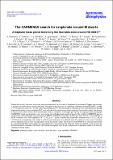Por favor, use este identificador para citar o enlazar a este item:
http://hdl.handle.net/10261/192482COMPARTIR / EXPORTAR:
 SHARE SHARE
 CORE
BASE CORE
BASE
|
|
| Visualizar otros formatos: MARC | Dublin Core | RDF | ORE | MODS | METS | DIDL | DATACITE | |

| Título: | The CARMENES search for exoplanets around M dwarfs: A Neptune-mass planet traversing the habitable zone around HD 180617 |
Autor: | Kaminski, Adrian; Trifonov, T.; Caballero, J. A. CSIC ORCID; Quirrenbach, Andreas; Ribas, Ignasi CSIC ORCID; Reiners, Ansgar; Amado, Pedro J. CSIC ORCID; Zechmeister, Mathias; Dreizler, S.; Perger, M. CSIC ORCID; Tal-Or, L.; Bonfils, Xavier; Mayor, M.; Astudillo-Defru, Nicola; Bauer, Florian Franz; Béjar, Victor J. S.; Cifuentes, C. CSIC ORCID; Colomé, J. CSIC ORCID; Cortés-Contreras, M. CSIC ORCID; Delfosse, X.; Díez-Alonso, E.; Forveille, T.; Guenther, E. W.; Hatzes, Artie P.; Henning, Thomas; Jeffers, Sandra V.; Kürster, M.; Lafarga, M. CSIC ORCID; Luque, R.; Mandel, H.; Montes, D.; Morales, Juan Carlos CSIC ORCID; Passegger, V.M.; Pedraz, S.; Reffert, S.; Sadegi, S.; Schweitzer, Andreas; Seifert, W.; Stahl, O.; Udry, Stephane | Palabras clave: | Stars: late-type Planetary systems Stars: individual: HD 180617 Stars: low-mass |
Fecha de publicación: | 2018 | Editor: | EDP Sciences | Citación: | Astronomy and Astrophysics 618: A115 (2018) | Resumen: | Despite their activity, low-mass stars are of particular importance for the search of exoplanets by the means of Doppler spectroscopy, as planets with lower masses become detectable. We report on the discovery of a planetary companion around HD 180617, a bright (J = 5.58 mag), low-mass (M = 0.45M) star of spectral type M2.5 V. The star, located at a distance of 5.9 pc, is the primary of the high proper motion binary system containing vB 10, a star with one of the lowest masses known in most of the twentieth century. Our analysis is based on new radial velocity (RV) measurements made at red-optical wavelengths provided by the high-precision spectrograph CARMENES, which was designed to carry out a survey for Earth-like planets around M dwarfs. The available CARMENES data are augmented by archival Doppler measurements from HIRES and HARPS. Altogether, the RVs span more than 16 yr. The modeling of the RV variations, with a semi-amplitude of K = 2.85-0.25 +0.16 m s-1, yields a Neptune-like planet with a minimum mass of 12.2-1.4 +1.0 M on a 105.90-0.10 +0.09 d circumprimary orbit, which is partly located in the host star's habitable zone. The analysis of time series of common activity indicators does not show any dependence on the detected RV signal. The discovery of HD 180617 b not only adds information to a currently hardly filled region of the mass-period diagram of exoplanets around M dwarfs, but the investigated system becomes the third known binary consisting of M dwarfs and hosting an exoplanet in an S-type configuration. Its proximity makes it an attractive candidate for future studies. © ESO 2018. | Descripción: | Michel Mayor (Nobel de Física 2019 por el descubrimiento del primer planeta extrasolar) | Versión del editor: | http://dx.doi.org/10.1051/0004-6361/201833354 | URI: | http://hdl.handle.net/10261/192482 | DOI: | 10.1051/0004-6361/201833354 | Identificadores: | doi: 10.1051/0004-6361/201833354 issn: 1432-0746 |
| Aparece en las colecciones: | (CAB) Artículos (IAA) Artículos (ICE) Artículos |
Ficheros en este ítem:
| Fichero | Descripción | Tamaño | Formato | |
|---|---|---|---|---|
| IAA_2018_Amado_aa33354-18.pdf | 1,57 MB | Adobe PDF |  Visualizar/Abrir |
CORE Recommender
SCOPUSTM
Citations
38
checked on 23-abr-2024
WEB OF SCIENCETM
Citations
27
checked on 22-feb-2024
Page view(s)
298
checked on 23-abr-2024
Download(s)
154
checked on 23-abr-2024
Google ScholarTM
Check
Altmetric
Altmetric
NOTA: Los ítems de Digital.CSIC están protegidos por copyright, con todos los derechos reservados, a menos que se indique lo contrario.
